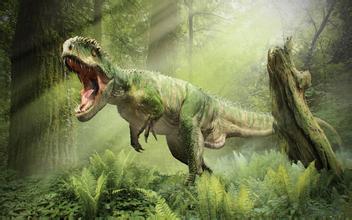This size difference is true with most dinosaurs, but in the case of T. Rex, it's extreme.
這種體積差異對大多數恐龍來說都一樣,但是對霸王龍來說它更極端。
The risk would be, if you really make her angry, she might eat you for lunch.
危險在于,如果你真把雌性惹怒她可能會把你當成午餐。
Even for a male who's made it this far, about to be rewarded with his prize, this one final challenge can be deadly.
甚至對一只已排除萬難想要得到獎賞的雄性霸王龍來說,這種最后的決斗會是致命的。
Now he's in the danger zone. He's within the killing zone.
他在危險地帶,在殺戮地帶內。
If the females reject him there, they can bite his head off, and that's the end of him in terms of Darwinian calculus.
如果雌性在那拒絕它,它們會把他的頭咬下來,根據達爾文理論來說它就完了。
But in the end, despite the many risks and hazards, the strongest, most well-adapted Tyrannosaurus Rex passes on his genes to a new generation...a generation that might just grow a little smarter, a bit stronger, and maybe even tougher than its parents.
但是最后不管有多少危險和障礙,最強壯的、適應力最好的雷克斯霸王龍還是把他的基因傳承到下一代,下一代可能會變得比他們的父母更聰明更強壯,甚至會更強悍。

For males, only the strongest or brightest win the right to their prize, and only their traits will be passed on.
對于雄性來說,最強壯的或者是最聰明的才能獲得交配權的獎勵,而且只有他們的特質可以傳承下去。
Perhaps a longer horn. A stronger frill. A bigger slashing claw. Better hearing, sight, or smell.
有可能是更長的尖角。更強壯的頭盾。更鋒利的爪子。更好的聽覺視覺或者嗅覺。
The genes for less useful traits eventually die out.
一些不太有用的基因最終會逐漸消失。
Fossil evidence tells us a lot much about how dinosaurs adapt, but reveals little about what courtship for these giants might have been like.
化石證據告訴我們很多恐龍是怎樣適應環境的,而很少顯示出這些巨型生物在求偶期會是什么樣。
If we imagine these big, 3,4-ton Tyrannosaurs doing these mating dances, it's kind of weird.
我們想象一下這些三四噸重的霸王龍跳一些求偶的舞蹈, 這是很詭異的。
But one thing we do know is that the dangers of mating are real.
但是有一件事我們已經知道,求偶是真的很危險。
Fossil evidence points to serious or even fatal injuries. Tails crushed. Ribs and vertebrae fractured. Skulls bitten.
化石證據顯示了更嚴重或更致命的傷。壓碎的尾部。斷裂的肋骨和脊椎。被咬傷的頭骨。
Dinosaurs create the next generation at their own risk.
恐龍在自擔風險創造下一代。
If there's going to be an attempt at mating on the part of the male, it really has to be certain that the female is receptive.
就雄性而言,如果他想要交配就必須得確定雌性是否能接受。
Because if she's not, she can say no in quite a dramatic and indeed a fatal way.
因為如果不能接受,她會用一種激烈和致命的方法來拒絕。
There's a reason why evolution put females in charge.
進化讓雌性在交配上有決定權是有原因的。
When it comes to reproduction, they do the real work, so they get to decide which traits survive and which ones just die out.
就繁殖后代而言,她們在做實際的工作,所以她們能決定哪些特質可以保留,哪些可以消失。
The females are really the vital link in the chain here. They're the ones that are building the babies.
雌性是這個過程里關鍵的一環。是她們在繁育后代。
But a little bit of sperm goes a long way, so most of the males are probably not going to be reproducing.
而那一點精子已經歷盡艱辛,所以大多數的雄性不會負起繁殖的責任。
Like animals today, most male dinosaurs battle it out for the chance to reproduce.
正如今天的動物,大多數雄性奮力爭奪繁殖的機會。
Females look for a male who can prove he's stronger, tougher, and maybe more clever in the competition.
雌性尋找一個競爭中能證明他的強壯堅韌和聰明的雄性伴侶。
But sometimes evolution goes another way and rewards highly unusual and very specialized traits.
但有的時候進化走向了另一端,并偏好那些不尋常而專門的特征。


